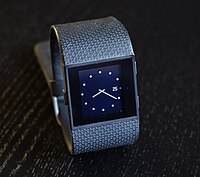
Photo from wikipedia
Dog-walkers are more likely to achieve moderate-intensity physical activity. Linking the use of activity trackers with dog-walking may be beneficial both in terms of improving the targeted behavior and increasing… Click to show full abstract
Dog-walkers are more likely to achieve moderate-intensity physical activity. Linking the use of activity trackers with dog-walking may be beneficial both in terms of improving the targeted behavior and increasing the likelihood of sustained use. This manuscript aims to describe the protocol of a pilot study which intends to examine the effects of simultaneous use of activity trackers by humans and their dogs on the physical activity level of humans and dogs. This study uses nonprobability sampling of dog owners of age 25–65 (N = 80) and involves four parallel groups in an observational randomized controlled trial with a 2 × 2 factorial design, based on use of dog or human activity trackers for eight weeks. Each group consists of dog-human duos, in which both, either or none are wearing an activity tracker for eight weeks. At baseline and end, all human subjects wear ActiGraph accelerometers that quantify physical activity for one week. Commercial activity trackers are used for tracking human and dog activity remotely. Additional measures for humans are body composition and self-reported physical activity. Dog owners also report dog’s weight and physical activity using a questionnaire. A factorial analysis of covariance (ANCOVA) is used to compare physical activity across the four groups from baseline to week-10.
Journal Title: International Journal of Environmental Research and Public Health
Year Published: 2021
Link to full text (if available)
Share on Social Media: Sign Up to like & get
recommendations!